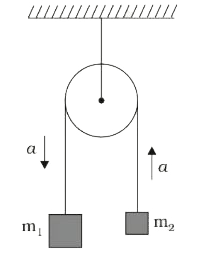Two bodies A and B of masses m and M (M>>m) have same kinetic energy, which body will have more momentum ?
To solve the problem of which body has more momentum when two bodies A and B of masses m and M (where M >> m) have the same kinetic energy, we can follow these steps:
Step 1: Write the formula for kinetic energy
The kinetic energy (KE) of an object is given by the formula:
KE=p22m
where p is the momentum and m is the mass of the object.
Step 2: Rearrange the formula to express momentum in terms of kinetic energy
From the kinetic energy formula, we can rearrange it to find momentum:
p2=2m⋅KE
Taking the square root of both sides gives:
p=√2m⋅KE
Step 3: Analyze the situation for both bodies
Since both bodies A and B have the same kinetic energy (let's denote it as KE), we can express the momentum for both bodies:
- For body A (mass = m):
pA=√2m⋅KE
- For body B (mass = M):
pB=√2M⋅KE
Step 4: Compare the momenta
Now, we can compare the momenta pA and pB:
pA=√2m⋅KE
pB=√2M⋅KE
Since M>>m, it follows that:
√M>>√m
Thus:
pB>pA
Conclusion
Therefore, body B, which has the greater mass, will have more momentum than body A.
The kinetic energy (KE) of an object is given by the formula:
KE=p22m
where p is the momentum and m is the mass of the object.
From the kinetic energy formula, we can rearrange it to find momentum:
p2=2m⋅KE
Taking the square root of both sides gives:
p=√2m⋅KE
Since both bodies A and B have the same kinetic energy (let's denote it as KE), we can express the momentum for both bodies:
- For body A (mass = m):
pA=√2m⋅KE
- For body B (mass = M):
pB=√2M⋅KE
Now, we can compare the momenta pA and pB:
pA=√2m⋅KE
pB=√2M⋅KE
Since M>>m, it follows that:
√M>>√m
Thus:
pB>pA
Therefore, body B, which has the greater mass, will have more momentum than body A.
Topper's Solved these Questions
- WORK ENERGY AND POWERBook:ICSEChapter: WORK ENERGY AND POWERExercise:EXERCISE-2(B) (MULTIPLE CHOICE TYPE )
Explore 2 Videos
- WORK ENERGY AND POWERBook:ICSEChapter: WORK ENERGY AND POWERExercise:EXERCISE-2(B) (NUMERICALS)
Explore 23 Videos
- WORK ENERGY AND POWERBook:ICSEChapter: WORK ENERGY AND POWERExercise:EXERCISE-2(A) (NUMERICALS)
Explore 16 Videos
- CALORIMETRYBook:ICSEChapter:CALORIMETRYExercise:EXERCISE-11(B) (NUMERICALS)
Explore 15 Videos
Similar Questions
Two bodies of masses m1andm2(<m1) are connected to the ends of a massless cord and allowed to move as shown in figure. The pulley is both massless and frictionless. The acceleration of the centre of mass is (m1−m2)n(m1+m2)2g. Find the value of n.

View SolutionTwo bodies of masses m1andm2 have same kinetic energy. The ratio of their momentum is
View SolutionA light body and a heavy body have the same kinetic energy which one has a greater momentum ?
View SolutionTwo bodies A and B having masses in the ratio of 3 : 1 possess the same kinetic energy. The ratio of their linear momenta is then
View SolutionSTATEMENT-1: If a car and truck hacve same momentum then the tr5uck has more kinetic energy
STATEMENT-2: If a car and truck have same kinetic energy then the truck has more momentum.
STATEMENT-3: If a car and truck have same kinetic energy then both have same momentum
View SolutionTwo bodies of different masses m1 and m2 have equal momenta. Their kinetic energies E1 and E2 are in the ratio
View SolutionTwo bodies of different masses m1 and m2 have equal momenta. Their kinetic energies E1 and E2 are in the ratio
View SolutionTwo bodies of different masses m1 and m2 have equal momenta. Their kinetic energies E1 and E2 are in the ratio
View SolutionTwo particles of masses m and 2m have equal kinetic energies. Their de Broglie wavelengths area in the ratio of:
View SolutionTwo bodies with masses m1kgandm2kg have equal kinetic energies. If p1andP2 are their respective momenta, then p1/P2 is equal to :
View Solution
